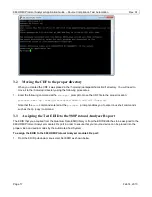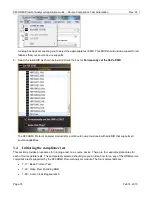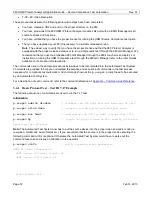
980 HDMI Protocol Analyzer Application Guide
– Source Compliance Test Automation
Rev. A1
Page 4
Feb 14, 2013
1.1.3
Running the Tests
Test automation on HDMI source devices involves the high level steps per test or test suite listed below.
Setting the 980 into the proper state
– The following tasks are accomplished using 980 Protocol
Analyzer commands that the Test Automation System has to execute at the 980 command line (pscope>)
through a telnet session.
o
Ensure that the 980 HDMI Protocol Analyzer module is in the proper mode (HDMI vs MHL).
o
Disable the 980 HDMI Protocol Analyzer module Tx port (the Tx port is only used when running HDMI
sink compliance tests).
o
Disable other optional modes such as Encrypted Link Analyzer mode.
o
Verify that the 980 HDMI Protocol Analyzer module capture engine is idle.
Setting the source device into the proper video and audio mode
– The following task ensures that the
source device under test is in the proper video and audio mode. This can be done using either of the
following methods:
o
Have the Automated Test System set the source device into the proper video and audio mode. This is
facilitated by the provisioning of the 980 HDMI Protocol Analyzer module
’s Rx port with an EDID that
all the capabilities of your source device.
Capturing data
– The following tasks are accomplished using 980 HDMI Protocol Analyzer commands
that the Test Automation System has to execute at the 980 command line (pscope>) through a telnet
session.
o
Clean out any existing log data.
o
(optionally) Verify that video is being received by the 980 HDMI Protocol Analyzer module and that the
HDMI source device is putting out the proper resolution, audio, etc.
o
Set the capture parameters such as buffer size and trigger condition.
o
Initiate the capture.
Processing captured data
– The following tasks are accomplished using 980 HDMI Protocol Analyzer
commands that the Test Automation System has to execute at the 980 command line (pscope>) through a
telnet session.
o
Generate timing information about incoming stream.
o
Generate decoded data from stream.
o
Index the decoded data.
Run compliance test script on captured data per CTS Test ID
– The following tasks are executed at the
linux shell. The compliance test scripts enable you to run multiple tests at once or you can run each test
individually.
o
Initiate a perl script to run a specific Test ID or multiple Test IDs.
View test result
s
o
Open up various results files in your favorite word processing software, e.g. Wordpad.



















